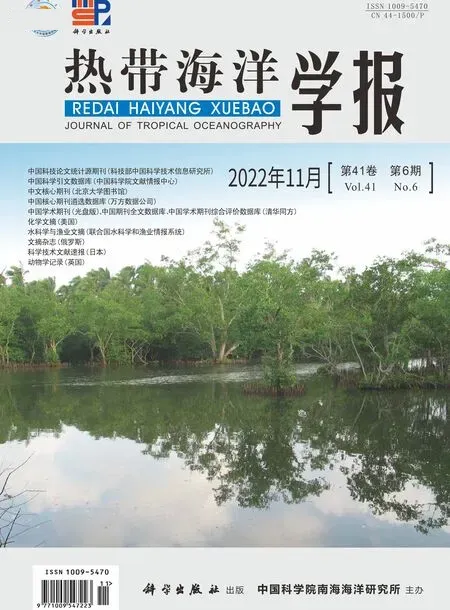廣東沿海紅樹林區(qū)水質(zhì)變化特征與富營養(yǎng)狀態(tài)評估
INYANG Aniefiok Ini , 周月月, 王友紹
1. 熱帶海洋環(huán)境國家重點(diǎn)實(shí)驗(yàn)室(中國科學(xué)院南海海洋研究所), 廣東 廣州 510301;
2. 中國科學(xué)院大亞灣海洋生物綜合試驗(yàn)站, 廣東 深圳 518121;
3. 中國科學(xué)院南海生態(tài)環(huán)境工程創(chuàng)新研究院, 廣東 廣州 510301;
4. 中國科學(xué)院大學(xué), 北京 100049;
5. 南方海洋科學(xué)與工程廣東省實(shí)驗(yàn)室(廣州), 廣東 廣州 511458
The environmental variables (such as water temperature, electrical conductivity, nutrient salts,turbidity, pH, Chla, etc.) of an aquatic ecosystem provide information of the ecosystem, which is vital for the productivity and survival of aquatic organisms.Such environmental variables govern the biotic relationships of organisms in the aquatic ecosystem,including the ability to withstand pollution load.Mangrove ecosystems is often observed along estuaries and coastal areas, a complex and dynamic aquatic environment that the river water mixes with seawater accompanied with a large number of physical and chemical processes that may influence the water quality (Morris et al, 2002). Its water is slightly alkaline and contains numerous dissolved substances that affect the biotic communities. Mangroves have the potential to improve the water quality of urban and rural runoff before being discharged into the adjacent coastal bays and/or oceans (Wang et al, 2019), but they can also be impaired by excessive pollutants from land sources(Wang and Gu, 2021). It provides an ideal nursery and breeding ground for most of the marine and brackish water fin and shell fishes (Jha et al, 2015) which served as a source of food for human. Generally, the benefits of mangrove ecosystems to human, wildlife, and global carbon balance have been undervalued and poorly managed globally (Wang, 2019).
Coastal water quality in different ecosystem ecosystems has been investigated with different parametric indices (Jha et al, 2015; Mukate et al, 2019;Miyittah et al, 2020), but mangrove ecosystems globally received little attention (Manju et al, 2012;Toriman et al, 2013; Pawar, 2013; Rahaman et al, 2013;Inyang et al, 2018; Rao et al, 2018; Samara et al, 2020)with no information in the mangroves of China. The coastal waters in Guangdong, China have received a large amount of nutrients and other pollutants from rivers and its watershed because of the rapid economic development and population growth during the past 30 years (Qu and Kroeze, 2010), making it important to evaluate the water quality across the mangrove ecosystem and prove evidence for spatiotemporal distribution of nutrient salts and algal biomass. The government report has claimed that water pollution is still a serious problem in Guangdong province and approximately 22.6% of river sections have a water quality worse than Grade Ⅲ of the environmental quality standards for surface water in China(Department of Environmental Protection of Guangdong Province, 2016). Therefore, we hypothesize that water quality and trophic state status in the mangrove ecosystems might show a significant spatial fluctuation because of differences in catchment characteristics (such as industrial development,agricultural activities, fish farming activities and urbanization) and river source input.
In the paper, we also hypothesized that due to the dilution effect caused by rainfall and flooding(freshwater input), the concentrations of nutrient salts and Chlain wet seasons would be significantly lower than those in dry seasons. And the study will be aimed at determining the current water quality status of the mangroves along the Guangdong coast with the following objectives: (1) to highlight the spatiotemporal characteristics of the water quality at the Guangdong mangrove area; (2) to evaluate the algal abundance, the single trophic state using TSI (Chla) method, and to reveal possible sources of variation in water quality in the mangrove forest using multivariate statistics.
1 Methodology
1.1 Study area
The sampling was collected at 34 sites throughout the Guangdong mangrove forest, at latitude 20°12′—25°31′N and longitude 109°45′—117°20′E(Fig. 1). The sampling sites are characterized by different species of true mangroves, such as:Acrostichumaureum,Excoecariaagallocha,Bruguieragymnorrhiza,Kandeliaobovata,Rizhophora stylosa,Lumnizera racemosa,Aegicera corniculatum,Avicennia marinaandAcanthus ilicifolius, and non-true mangrove species e.g.,Pongamia pinnata,Hibiscus tiliaceus,Thespesia populnes,Herltiera littoralis,Cerbera manghas,Clerodendrum inermeandPluchea indica(Inyang and Wang, 2020). The mangrove ecosystems in Guangdong are influenced by semidiurnal to mixed tides all year long, with a tidal range of 0.8 m during neap tides and 4.0 m during spring tides. The average annual precipitation in the study region is ~2,000 mm(Liu, 2013), and approximately 85% of the total rainfall is concentrated in the rainy season from April to September. The study sites were selected along the mangrove ecosystem of the Guangdong province,China, from the Leizhou Peninsula in the west to the east. Some sections of the mangrove floor are covered with algal bloom (Fig. 2), which has resulted in the death of some mangrove species (Fig. 2a).

Fig. 1 The location map of the study areas along the Guangdong coast. The map review number is given as GS (2019) 3333
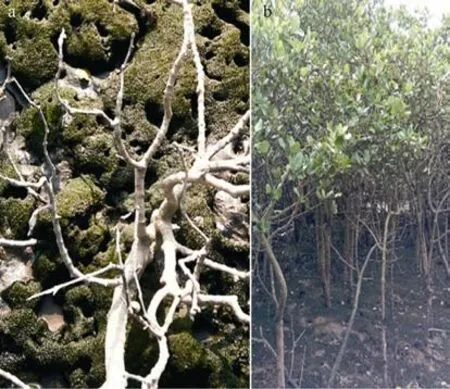
Fig. 2 Algal bloom on the floor of mangrove forest(Avicennia marina) around Peninsula and mid part of the Guangdong coast exposed during low tide. (a) Long term severe environmental pollution result in the mangrove plant death; (b) A. marina bed covered with algal bloom due to the long term nutrient enrichment
1.2 Sampling and analysis of the environmental variables
Water quality monitoring was carried out in the dry season from October, 2017 to January, 2018, and in the wet season from July to August, 2018. At each investigation site, the environmental parameters such as water temperature, pH, salinity, electrical conductivity (EC), turbidity and total dissolved solids(TDS) were measuredin-situusing a Quanta? Water Quality Monitoring System (Hydrolab Corporation,USA) during high water level within the depth of 1m.300 mL of surface water was sampled using GO FLO bottles for analysis of nutrients (phosphate, nitrate,nitrite and silicate). The water sample was filtered using 0.22 μm Whatman? GF/F filters before analysis.Within 2–3 h after sampling, nitrate (NO3-N), nitrite(NO2-N) and silicate (SiO3-Si) were analyzed with a SKALAR auto-analyzer (Skalar Analytical B.V.SanPlus, Holland). Phosphate (PO?-P) was pretreated using an oxidization method by hypobromite before analysis using an auto-analyzer. Chlorophyllaanalysis was carried out according to HELCOM (2015)using a SHIMADZU Spectrophotometer (UV-1700,Japan).
1.3 Statistical analysis
Multivariate analytical techniques were employed to extract the spatiotemporal patterns and trends in water quality data to enhance the understanding of hidden information within the data. Various multivariate statistical methods were used in our study,including correlation analysis, principal component analysis and cluster analysis, using PRIMER v.7(PRIMER-E Ltd, Roborough, Plymouth, UK).
The trophic state was evaluated by single factor index, trophic state index (TSI) Chla. The equation for TSI (Chla) is as follows (Wang et al, 2002):

Evaluation standard: 0<TSI≤30 oligotrophic,30<TSI≤ 50 mesotrophic, TSI>50 eutrophic, >70 high eutrophic.
2 Results
2.1 Spatiotemporal variation of environmental variables in the mangrove ecosystem
The environmental variables of the mangrove ecosystem along the Guangdong coast, South China Sea are presented in Table 1. Meanwhile, various levels of significance (P<0.01 orP<0.05) were established among the measured physiochemical parameters (Tab.2). Generally, the nitrate concentration across the mangrove forest fluctuated greatly in the dry season than in the wet season. Generally, the spatiotemporal variation of the nutrient salts was significantly different between the two seasons (P<0.01), with the dry season recording the high concentration values (Tab. 1).Although there were spatial differences in nutrients distribution between the left and right sides of the Leizhou Peninsula (Fig. 3), the mean nutrient concentration across the left side was significantly lower than the east part of the Guangdong coast during both seasons (P<0.01). Meanwhile, nutrient salts concentration showed no significant difference (P<0.01 orP<0.05) between the two sides of the Leizhou Peninsula. Chlaconcentrations varied greatly across the sampling sites with a mean value of 1.82 mg·m-3and 8.38 mg·m-3in both the wet and dry season,respectively; and were influenced by pH, salinity, and nutrient salts (Tab. 2). Its highest value in the wet season was 13.53 mg·m–3(GD11), while the lowest value was 0.14 mg·m-3(GD20), while in the dry season,its maximum and minimum values were recorded as 0.75 mg·m-3(GD23) and 38.08 mg·m-3(GD36),respectively. Moreover, the Chlaconcentration was significantly higher on the east coast than the left side of the Leizhou Peninsula (P<0.01). Temporally, Chlaconcentration varied significantly between the dry and wet seasons (P<0.05), but showed no significant difference between the left and the right side of the Leizhou Peninsula (P<0.01), Fig. 3.

Fig. 3 Variations in micronutrient (mg·L–1) and Chl a (mg·m–3) concentration during the dry and wet season
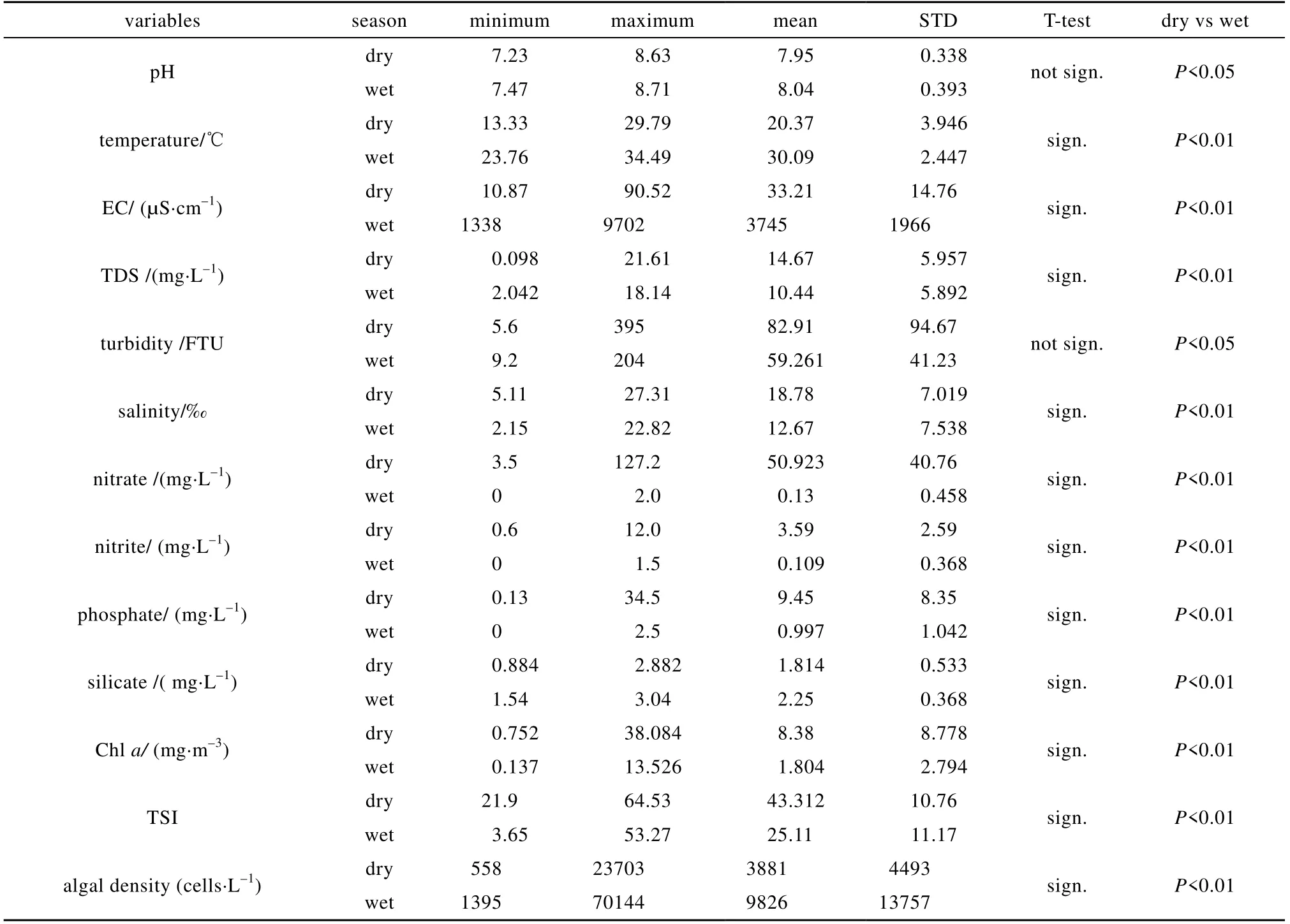
Tab. 1 Spatiotemporal variation and T-test evaluation of environmental parameters during dry season (n = 30) and wet season (n = 23) in the mangroves
2.2 The relationship between environmental characteristics and trophic states
The Correlation coefficient was used to confirm the linear relationship between the environmental variable and the TSI (Chla) and algal cells abundance during both seasons (Tab. 2). TSI (Chla) evaluation indicated that trophic states of the study area ranged from oligotrophic to eutrophic (Fig. 2). There was a significant difference between the rainy season and the dry season for the TSI (P<0.05). The mean TSI in the wet season was 25±11.2, which was significantly lower than that in the dry season (mean TSI 43±10.8) (P<0.05). At the Leizhou Peninsula, the TSI (Chla) showed no significant difference between the left and right side of the Leizhou Peninsula during both seasons but spatial differences were found. Relatively, the left side of the Leizhou Peninsula reported high TSI values than the right side and was significantly different from the east part of the coast (Fig. 4). Meanwhile, across the mangrove forest, in the dry season, the eutrophication state was alarming than in the wet season. Based on environmental variables pattern and TSI, we found that hydrological variables such as; pH, nitrate, and nitrite were a vital component of the ecological process that influenced the trophic state in the mangrove ecosystem (P<0.01 orP<0.05) during the dry season. Other parameters that positively impacted the TSI were salinity and EC during both seasons. The algal cell abundance in the mangroves was greatly influenced by nitrate and nitrite (P<0.01 orP<0.05) during the dry season, while in the rainy season, a positive relation was observed with phosphate and salinity (Tab. 2). Its spatiotemporal distribution (Fig. 5) showed that the maximum algal density was recorded as 38.97×106cells·L–1(GD15) and as 13.17×106cells·L–1(GD40) in the wet and dry seasons, respectively. The algal density was higher in the wet season than in the dry season(P<0.05, Fig. 4). Moreover, its spatial distribution was significantly different during the wet and dry seasons(P<0.01).
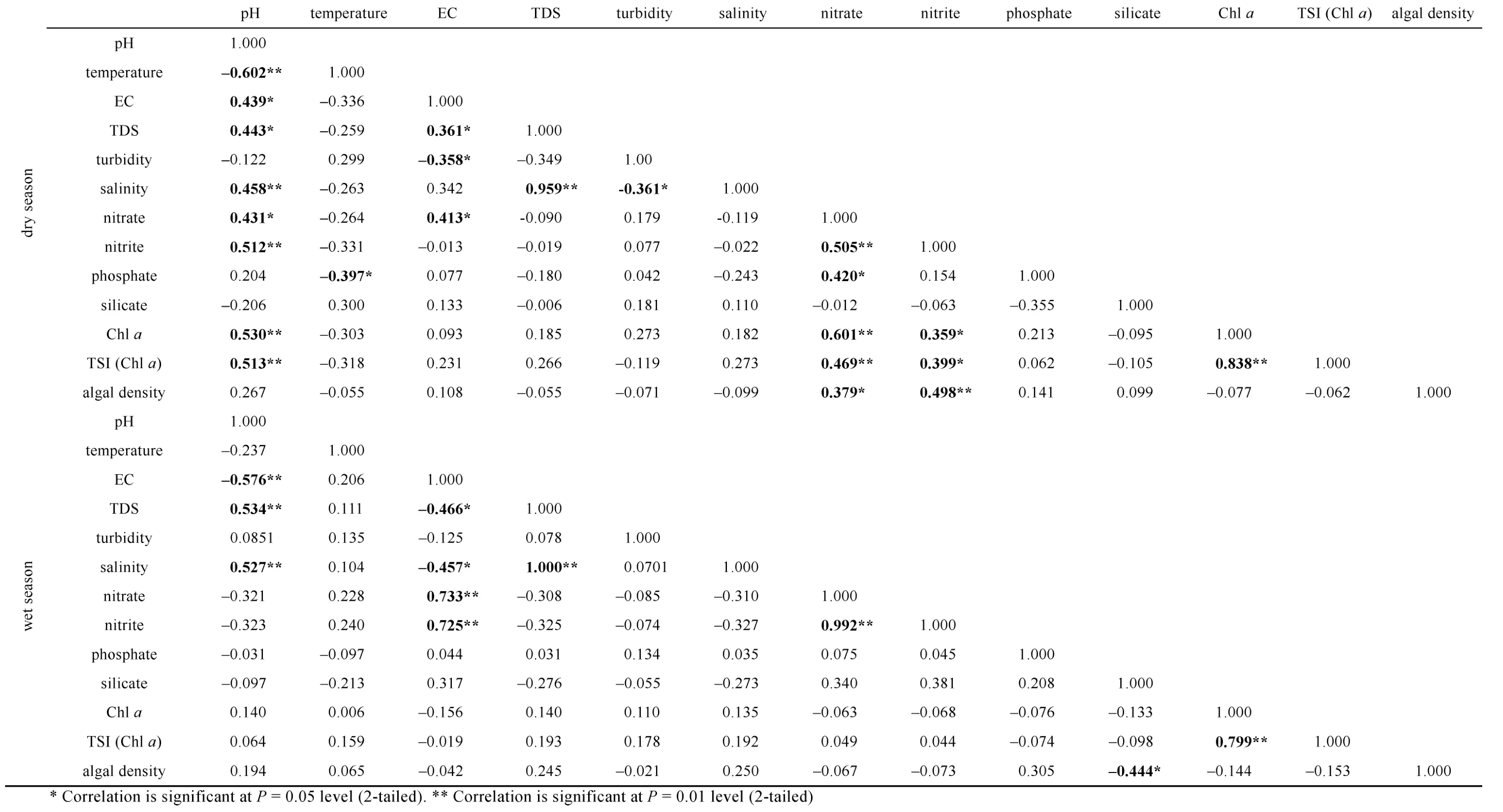
Tab.2 Pearson correlation coefficient of environmental parameters in the mangroves during the wet season (n = 23) and dry season (n =30)
2.3 Multivariate analysis of environmental variables in the mangrove ecosystems
2.3.1 Cluster analysis Cluster analysis was used to group the sampling sites into different trophic states. This analysis grouped the studied sites into 3 main groups during the dry season and 2 main groups during the wet season (Fig. 6 and Fig.7). In the dry season, eutrophic stations were at study sites GD35, GD36 and GD37, located toward the east part of the Guangdong coast. The Oligotrophic stations were GD4, GD5, GD7 and GD33, found on the right side of the Leizhou Peninsula. Meanwhile, the mesotrophic conditions constituted the greater number of sites across the Leizhou Peninsula and the east part of the Guangdong coast (Fig. 6). In the wet season, eutrophic conditions were only found at GD11 located on the left side of the Leizhou Peninsula, while mesotrophic conditions were found at GD8, GD13, GD15, GD17 and GD34, located on both sides of the peninsular. The eastern part of the Guangdong coast was mainly oligotrophic (Fig. 7). The temporal trophic fluctuations confirm that the water quality was relatively better during wet season than dry season. Other environmental parameters that impacted the water quality were pH,salinity, water temperature, EC and turbidity.2.3.2 Principal component analysis
The PCA results were shown in Fig. 8. During the dry season, four principal components were generated,accounting for 75.7% of the total variance retained based on the eigenvalue > 1 rule. The first two principal components explained 34.3% and 17.6% of the total variance, respectively. The third and fourth components were considerably less important, accounting for only 14.2% and 9.5% of the total variance, respectively.Thus, the first two components were considered, which accounted for large proportions (~52.0%) of the variation in the dataset. As shown in Fig. 8, the spatial characteristics of trophic status in the mangroves can be clearly observed, where the nutrient salts were the key parameters affecting algal communities in the mangroves. In the wet season (Fig. 8), the PCA generated four principal components, which accounted for 71.5% of the total variation retained based on the eigenvalues > 1 rule. Component 1 accounted for 31.4%,while component 2 explained 17.7% of the total variance.The third and fourth components with less important consideration explained 11.9% and 10.4% of thedata variance, respectively. Thus, the first two components were considered to be significant,which accounted for large proportions (49.2%) of the total variance. Component 1 was characterized by nitrate, nitrite, salinity, pH and EC which play a major role in spatial distribution of phytoplankton in the mangroves.
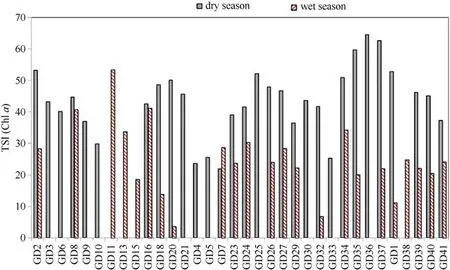
Fig. 4 The spatiotemporal distribution of trophic state index in the mangroves

Fig. 5 Spatiotemporal variations in algal cell abundance across the mangroves during dry and wet season. Cells abundance data is given in ×106 cells·L–1
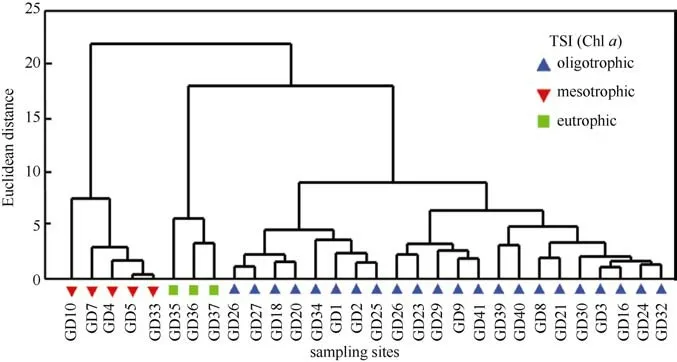
Fig. 6 Dendrogram based on Ward's method, clustering of the sample sites based on trophic state in the mangroves during the dry season

Fig. 7 Dendrogram based on Ward's method, clustering of the sample sites based on trophic state in the mangroves during the wet season

Fig. 8 PCA analysis of the environmental parameter in the mangroves during the dry and wet season
3 Discussion
3.1 Spatial and temporal fluctuation in the water quality variables in the mangrove ecosystems
Water temperature is influenced by weather conditions of an area or region. Still, it could also be affected by the industrial discharge of thermal effluence within a local niche (Jiang et al, 2013),causing biological imbalance in the ecosystem. Salinity is known to be an important parameter in the estuarine and mangroves that affects the distribution and physiology of living fauna and flora. The spatiotemporal variability in the salinity levels in the study area was within the range of brackish water environment (2.15‰~28.82‰).Similarly, observations were made at different mangrove ecosystems during the dry and wet season(Miyittah et al, 2020). These studies attributed the low salinity content in the surface water to strong rainfall events and an influx of freshwater into the system.Across the mangroves, a temporary increase in salinity content coincided with a decrease in water temperature and vice versa. This explains why evaporation plays little or no role in salinity variation; rather,marine/freshwater exchange coupled with surface water dilution by rainfall was the key player in salinity variation. Salinity is a limiting factor in the distribution of living organisms, and its changes are likely to affect biological communities (Inyang and Wang, 2020). The pH in surface waters remained alkaline throughout the study period, and its range value was within the limit reported elsewhere in the mangroves (Toriman et al, 2013; Miyittah et al, 2020;Samara et al, 2020). Generally, pH plays a vital role in the distribution of biological communities in the estuaries (Inyang and Wang, 2020). The EC variation in surface waters is influenced by dissolved ions of natural and anthropogenic origins. Inyang et al (2018)concluded that EC significantly depends on salinity,TDS, total cation and anion concentration in the mangrove ecosystem. Higher EC in the dry season could be attributed to the influx of saline water plus contaminated substances from the fish farming facilities, while its high value during the wet season is an indication that a proportion of the dissolved ions were transported into the forest by surface runoff from non-point sources such as agricultural farmlands and fish farming facilities which are dominant land use within the littoral fringes.
Turbidity measurement in surface waters is an indication of the presence of suspended solids(plankton, sediment particles, etc.) and dissolved organic matter. The observed positive correlation between turbidity and Chladuring both seasons confirmed that particles in suspension in the mangrove forest are nutrient-rich that enhance the productivity of phytoplankton. Inyang et al (2018) concluded that rainfall directly increased the turbidity load through runoff. Turbidity is the most visible indicator of water quality in coastal waters. Increased turbidity can hinder sunlight penetration in coastal surface waters,thereby affecting phytoplankton productivity and vice versa. The right side of the Leizhou Peninsula was observed to have experienced high turbidity during both seasons due to the large volume of waste water discharged from the fish pond facilities, small fragmented mangrove areas that have little buffering capacity and tidal influence. The significant relationship between turbidity and salinity indicates that salinity is largely influenced by the processes that increased the turbidity level in the mangrove ecosystem. The nutrient salts fluctuate spatially and temporally across the mangrove ecosystem. The coastal waters in China are known to be eutrophic due to nutrient generating activities such as aquaculture,agriculture, industrial activities, sewage disposal from the urban cities and tourism along the coast. The temporal variation in the nutrients may have been resulted from biological activities, physical and chemical properties of the water. Meanwhile, the changes in nutrient concentration in this study could be attributed to the difference in catchment characteristics and mangrove coverage area.MacDonnell et al (2017) reported that nutrient salts were indicators of the mangroves’ hydrogeomorphic settings, including tidal fluxes and urban storm water runoff. High nutrient concentration in the mangroves could generally lead to accelerated changes (Geedicke et al, 2018), such as alteration of biological processes and increased N2O fluxes to the atmosphere, which may contribute to global warming (Reis et al, 2017)and reduction in services such as improvement of water quality (Reis et al, 2017). Tjandraatmadja and Diaper (2006) confirmed that the increase in nutrient concentration in the surface water essentially comes from municipal wastes and runoff from agricultural effluents.
3.2 Temporal variation in chlorophyll-a and trophic states
Chlaconcentration that reflects the primary productivity and trophic condition in estuaries, coastal and oceanic waters is the net result (standing stock) of both growth and loss processes. Its positive corrections with nitrate, nitrite and phosphate explain the effect of the nutrient salts on the water quality of the mangroves. Manju et al (2012) establish a positive correlation between nutrient salts and Chlain the mangroves of the Kerala Coast. Generally, high nutrient concentration in coastal waters causes eutrophication (Song et al, 2009; Hou et al, 2018). The study established a positive and significant temporal difference (P<0.05 orP<0.01) between nutrient salts and the trophic state index. The trophic state analysis confirmed that the surface water of the mangrove ecosystem during the dry season was mainly mesotrophic to eutrophic, whereas in the wet season it was eutrophic, mesotrophic, and oligotrophic. The spatiotemporal difference in trophic index variation from the left of the Leizhou Peninsula to the east part of the coast could be attributed to differences in catchment characteristics that possibly affect nutrient concentrations and turbidity levels; changes in pH,salinity and EC that affect algal development; and changes in mangrove coverage areas that provide a calm and enabling environment for algal proliferation.The coastal eutrophication in the mangroves has been linked to the impact of anthropogenic nutrient input(Valiela et al, 2009). This nutrient input, together with other factors (pH, salinity, EC, etc.) and zooplankton grazing, causes Chlaconcentration to be either high or low in the mangroves.
3.3 Multivariate analysis of environmental parameters in the mangroves
Cluster analysis which detected similar groups between the sampling sites in the mangroves during the dry and wet season has significantly delineated 3 groups and 2 groups of samples during the dry and wet season, respectively. These sample groups were impacted by different environmental parameters,mostly by turbidity, EC, salinity, water temperature and nutrient salts. Turbidity and nutrient salts concentration are associated with human activities along the littoral fringes of the mangroves and therefore serve as a better environmental indicative parameter for future monitoring. The trophic differences in the study area could be linked to the anthropogenic nutrient input (Valiela et al, 2009)and mangrove hydrogeomorphic differences(MacDonnell et al, 2017). The CA revealed that the water quality during the wet season was relatively better compared to the dry season. In contrast,MacDonnell et al (2017) reported high nutrient concentrations during the wet season at mangrove wetlands in Southwest Florida. It can be stated that hierarchical CA provided a reliable tool for surface water analysis in the study area (Inyang et al, 2018)and made it possible to optimize future monitoring programs. The PCA results explain that nutrient salts play an important role in the water quality across the Guangdong mangroves. Though other physiochemical parameters exerted significant change on-site, their effects on the algal community cannot be overemphasized (Inyang and Wang, 2020).Human activities have a strong influence on the mangroves in the Guangdong coastal area.
4 Conclusions
The study confirmed our two hypotheses and revealed that the application of different multivariate statistical techniques to evaluate variations in the water quality of the mangroves should be adopted.This evaluation of the spatial variation of the water quality and the application of a single factor index(TSI Chla) to assess the trophic state across the Guangdong mangroves has revealed that the water quality during the dry season was bad and was relatively better in the wet season. The spatial evaluation of the water quality around the Leizhou Peninsula revealed that the right side was mainly mesotrophic (dry season) and oligotrophic (wet season), while the left side was mesotrophic during both seasons. The east part of the Guangdong coast experienced eutrophic conditions during the dry season and oligotrophic conditions during the wet season. Catchment characteristics, mangrove hydrogeomorphic, and tidal influx played a key role in water quality differences across the mangroves. The Chlaconcentration in the mangroves was affected by nutrient input, physical factors (pH, salinity, EC, etc.),algal assemblage, and zooplankton grazing.Meanwhile, the nutrient concentration was higher in the dry season across the mangroves compared to the wet season. The following stations experienced mild eutrophication: GD2, GD25, GD35, GD36 and GD37(dry season) and GD11 (wet season). There is an urgent need to maintain afforestation of the lost mangrove forest areas and discouragement of the fragmentation of the mangroves that could easily result in habitat loss.
——李振聲

